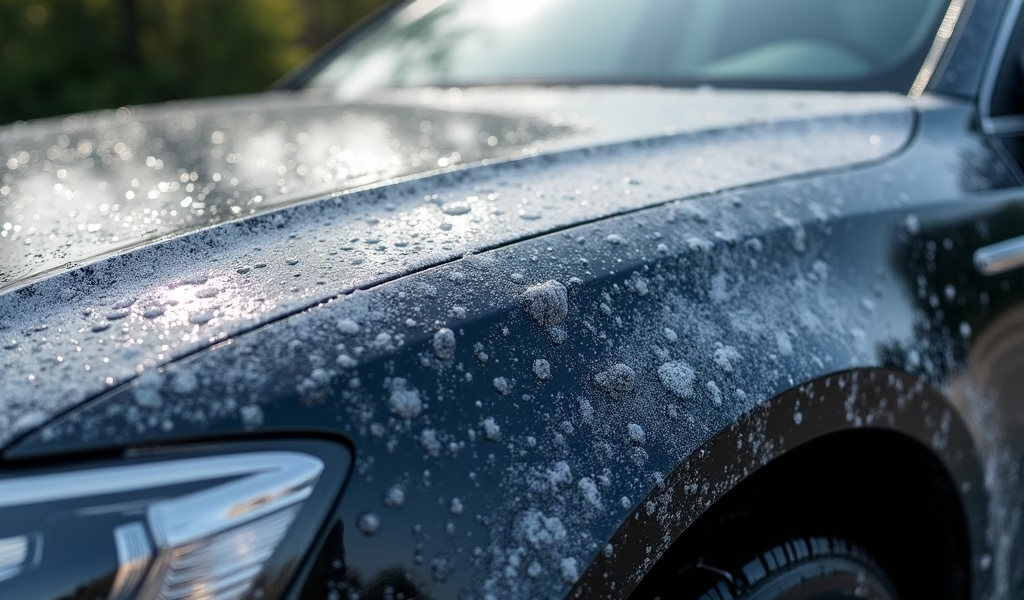Overview
This detailed guide to hand washing your car covers everything from essential supplies and the two-bucket method to professional drying techniques and protective finishing treatments. It emphasizes how proper hand washing not only creates a show-stopping shine but also preserves your vehicle’s paint and value over time, with specific techniques like clay bar treatments and protective sealants that produce professional-quality results.
Table of Contents
- Understanding the Art of Hand Washing Your Car
- Essential Supplies for a Professional Hand Wash
- Pre-Wash Techniques: Starting on the Right Foot
- The Two-Bucket Method: A Game Changer
- Proper Drying Techniques to Prevent Water Spots
- 5 Proven Shine Hacks for Show-Stopping Results
- Protecting Your Finish: Sealants and Waxes
- Conclusion
- Frequently Asked Questions
Understanding the Art of Hand Washing Your Car
Nothing beats the satisfaction of a properly executed car wash hand wash. While automatic car washes offer convenience, they simply can’t match the attention to detail and care of washing by hand. As a professional detailer with over 15 years of experience, I’ve seen firsthand how regular hand washing not only keeps your vehicle looking pristine but also protects your investment by preserving the paint and finish.
Hand washing allows you to spot potential issues like small scratches or chips before they become bigger problems. You’ll develop an intimate knowledge of your car’s exterior condition that automated systems just can’t provide. Plus, there’s something deeply satisfying about transforming a dirty vehicle into a gleaming showcase with your own two hands.
Many car enthusiasts consider the ritual of hand washing their vehicles to be therapeutic – a chance to disconnect from technology and focus on a tangible task with immediate, visible results. According to a Consumer Reports study, proper hand washing techniques can extend your car’s paint life by years compared to frequent automatic washes.
Essential Supplies for a Professional Hand Wash
Before diving into the process, gathering the right car cleaning products is crucial. Quality tools make all the difference between a mediocre wash and professional-level results. Here’s what you’ll need:
- Two large buckets (one for wash solution, one for rinsing)
- Grit guards for both buckets
- pH-neutral car wash soap (never use dish soap or household cleaners)
- Multiple microfiber wash mitts or sponges
- Wheel cleaning brush with soft bristles
- Microfiber drying towels (at least 2-3)
- Detailing spray for touch-ups
- Optional: foam cannon attachment for pressure washer
Investing in quality microfiber products is essential. Cheap alternatives can trap particles that scratch your clear coat. I recommend dedicated microfiber towels for different areas – separate ones for wheels, paint, and glass surfaces to prevent cross-contamination.
When selecting a car wash soap, look for pH-balanced formulations specifically designed for automotive finishes. These products safely remove dirt without stripping protective waxes or sealants. Many professional detailers prefer concentrated formulas that can be diluted according to how dirty the vehicle is.

Pre-Wash Techniques: Starting on the Right Foot
A proper pre-wash routine significantly improves your final results by safely removing larger debris before you make contact with the paint. Park your vehicle in a shaded area – direct sunlight causes soap and water to dry too quickly, leading to water spots and soap residue.
Start by thoroughly rinsing the entire vehicle with a pressure washer or garden hose. Work from top to bottom, allowing gravity to carry dirt downward. This initial rinse removes loose contaminants that could otherwise become abrasive particles during the washing process.
For heavily soiled vehicles, consider using a foam cannon or pre-wash spray. These products create a thick layer of detergent that clings to the surface, breaking down road grime, bug splatter, and other stubborn contaminants. Allow the pre-wash solution to dwell for 3-5 minutes (but never let it dry on the surface).
Pay special attention to lower panels, wheel wells, and front bumpers where road debris accumulates most heavily. A study by detailing experts found that proper pre-washing can remove up to 70% of contaminants before a wash mitt even touches the paint, dramatically reducing the risk of swirl marks and scratches.
The Two-Bucket Method: A Game Changer
The two-bucket washing method is the gold standard for preventing paint damage during a car wash hand wash. This approach uses one bucket with your soap solution and a second bucket with clean water for rinsing your wash mitt. Each bucket should have a grit guard at the bottom.
Start by filling your wash bucket with water and the manufacturer’s recommended amount of car wash soap. Fill the rinse bucket with clean water only. The process is simple but effective:
- Dip your clean microfiber wash mitt into the soap solution
- Wash a small section of the vehicle (2-3 square feet maximum)
- Rinse the mitt thoroughly in the clean water bucket before reloading with soap
- Repeat for each section, working from the top down
This methodical approach prevents dirt particles from being reintroduced to your paint surface. The grit guards at the bottom of each bucket allow dirt to settle beneath them, preventing your mitt from picking up settled contaminants when you dip it.
Always use straight-line motions rather than circular ones when washing. Straight lines make any potential scratches less noticeable than swirl marks created by circular motion. And remember to use a fresh side of your wash mitt as you move to new sections.
For heavily soiled areas like lower panels, use a separate wash mitt to avoid transferring excessive grime to cleaner areas. This self-car wash technique might seem time-consuming, but the extra minutes spent will save you hours of paint correction down the road.
Proper Drying Techniques to Prevent Water Spots
Drying is perhaps the most underrated step in achieving professional results. Water spots occur when minerals in water remain on your paint after the liquid evaporates. These deposits can etch into your clear coat if left untreated, causing permanent damage.
After rinsing away all soap residue with clean water, begin the drying process immediately. Start with a high-quality microfiber drying towel with at least 300 GSM (grams per square meter) thickness. Pat dry rather than wipe when possible, especially on horizontal surfaces where water pools.
For larger vehicles, consider using a leaf blower on a low setting to remove water from crevices, panel gaps, mirrors, and grilles before touching the surface with towels. This dramatically reduces the amount of hand drying required and minimizes the risk of introducing scratches.
Another professional technique involves using a drying aid spray. Simply mist a detail spray onto a panel before drying it with your microfiber towel. The lubricants in the spray help the towel glide across the surface while adding a touch of protection and shine.
For the ultimate streak-free finish on windows, use a waffle-weave microfiber cloth designed specifically for glass surfaces. The textured pattern lifts and traps water rather than pushing it around, leaving crystal clear results every time.

5 Proven Shine Hacks for Show-Stopping Results
After mastering the basics of a proper hand wash, these five professional detailer secrets will take your results to the next level:
1. Clay Bar Treatment
Even after a thorough wash, microscopic contaminants remain embedded in your clear coat. A clay bar treatment removes these impurities by shearing them away from the surface. Spray a clay lubricant on a small section, then gently glide the clay across the surface in straight lines. You’ll literally feel the difference as the paint becomes glass-smooth.
Perform this treatment 3-4 times per year for daily drivers or before applying any sealant or wax. The results are immediately noticeable – your paint will have a deeper, more reflective appearance that no amount of washing alone can achieve.
2. The Isopropyl Alcohol Wipe
Professional detailers often use a 50/50 mix of isopropyl alcohol and distilled water as a final wipe before applying protection products. This solution removes any remaining oils, soap residues, or previous product buildup without harming your clear coat.
Apply the mixture to a clean microfiber towel and wipe down panels before applying wax or sealant. This ensures your protection products bond directly with the paint surface rather than contamination layers, dramatically improving durability and appearance.
3. The Sheet Test
To verify your car is truly clean and properly protected, perform the “sheet test” after washing. Rinse your vehicle with clean water and observe how it behaves on the surface. On a well-maintained finish, water should sheet off in large, continuous flows rather than beading up or clinging to the surface.
Poor sheeting indicates contamination or degraded protection. When water sheets cleanly off your vehicle, you’ll experience faster drying times and fewer water spots.
4. The Dawn Dish Soap Reset
While dish soap is normally forbidden for regular car washing, it serves a specific purpose in a detailer’s arsenal. When you want to completely strip old waxes and sealants for a fresh start, a small amount of Dawn dish soap in your wash bucket will remove virtually all protection products.
Use this method sparingly – only when you plan to immediately apply new protection afterward. This “reset wash” gives you a clean canvas before applying premium waxes or ceramic coatings.
5. The No-Wash Enhancement
Between full washes, maintain your vehicle’s appearance with waterless wash products. These specially formulated sprays contain lubricants and cleaning agents that safely remove light dust and fingerprints without scratching.
Simply spray onto the surface and wipe with a clean microfiber towel. This extends the time between full washes and keeps your car looking fresh with minimal effort. It’s perfect for quick touch-ups before special events or weekend drives.
Incorporating these professional techniques into your car wash kit routine will transform ordinary results into head-turning finishes that rival professional detailers.
Protecting Your Finish: Sealants and Waxes
The final step in any professional-grade hand wash is applying protection. Think of this as sunscreen for your paint – it shields against UV damage, chemical contaminants, and makes future washing easier by creating a slick surface that dirt struggles to bond with.
Traditional carnauba waxes offer warm, deep gloss with moderate protection for 4-8 weeks. They excel at enhancing deeper colors like reds and blues with a wet, glowing appearance. Apply in thin layers using a foam applicator pad with straight, overlapping motions.
Synthetic sealants provide longer-lasting protection (3-6 months) with brilliant reflectivity and superior chemical resistance. They’re ideal for daily drivers exposed to harsh environmental conditions. Most modern sealants are incredibly easy to apply – simply spray on and wipe off with minimal effort.
For the ultimate in protection, ceramic coatings create a semi-permanent bond with your paint that can last 1-5 years depending on the formulation. While professional application is recommended for true ceramic coatings, consumer-grade “ceramic sprays” offer a taste of this technology in an approachable format.
Regardless of which protection you choose, always apply these products in a shaded area to a cool surface. Work in sections, and follow manufacturer directions precisely for curing times and application techniques. The extra 30-45 minutes spent applying protection saves hours of intensive cleaning down the road.
Conclusion
Mastering the art of the car wash hand wash isn’t just about keeping your vehicle clean – it’s about preserving its value, enhancing its appearance, and taking pride in proper maintenance. The five shine hacks we’ve explored represent the difference between an average wash and professional-caliber results that turn heads.
Remember that consistency matters more than perfection. Establishing a regular washing routine using proper techniques will yield better long-term results than occasional intensive detailing sessions. Your vehicle faces constant exposure to contaminants, so regular maintenance is essential.
By implementing the two-bucket method, paying attention to proper drying techniques, and applying quality protection products, you’ll not only achieve incredible results but also extend the life of your vehicle’s finish for years to come. Your car is likely one of your largest investments – treating it with the care it deserves through proper hand washing is both financially smart and deeply satisfying.
Frequently Asked Questions
How often should I hand wash my car?
Most vehicles benefit from bi-weekly washing, though this varies based on your environment and driving conditions. Increase frequency if your car is exposed to bird droppings, tree sap, or road salt.
Can I use dish soap to wash my car?
Never use dish soap for regular car washing as it strips protective waxes and can damage rubber seals. Only use pH-balanced automotive wash soap designed specifically for vehicles.
What’s the best time of day to wash my car?
Early morning or late afternoon in a shaded area provides ideal conditions. Avoid washing in direct sunlight as rapid drying causes water spots and soap residue.
How can I prevent swirl marks when washing?
Use the two-bucket method with grit guards, quality microfiber wash mitts, and wash in straight-line motions rather than circles. Always pre-rinse thoroughly before touching the paint with your mitt.
Is a pressure washer necessary for a good hand wash?
While helpful, a pressure washer isn’t essential for excellent results. A standard garden hose with an adjustable nozzle works perfectly fine for most home car washing needs.

